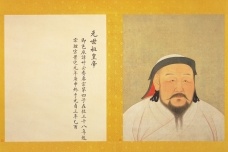
newspaper
agenda cultural
The Metropolitan Museum of Art will present a major international loan exhibition devoted to the art of the Yuan dynasty (1271-1368)—one of the most dynamic and culturally rich periods in Chinese history—beginning September 28. Bringing together over 200 works drawn principally from China, with additional loans from Taiwan, Japan, Russia, Germany, the United Kingdom, Canada, and the United States, The World of Khubilai Khan: Chinese Art in the Yuan Dynasty will explore the art and material culture that flourished during the pivotal and vibrant period in Chinese culture and history dating from 1215, the year of Khubilai Khan's birth, to 1368, the fall of the Yuan dynasty. The assemblage of extraordinary works will include paintings and sculpture, as well as decorative arts in gold and silver, textile, ceramics, and lacquer, and the exhibition will highlight new art forms and styles that were generated in China as a result of the unification of the country under the Yuan dynasty, founded by Khubilai in 1271. The loans from China will include key pieces from recent archaeological finds that add immeasurably to our knowledge and understanding of Chinese art of this period.
The exhibition is made possible by Bank of America.
The exhibition is also made possible by the E. Rhodes and Leona B. Carpenter Foundation, The Andrew W. Mellon Foundation, The Dillon Fund, The Henry Luce Foundation, Wilson and Eliot Nolen, The Miriam and Ira D. Wallach Foundation, the Oceanic Heritage Foundation, the National Endowment for the Arts, Florence and Herbert Irving, and Jane Carroll.
It is supported by an indemnity from the Federal Council on the Arts and the Humanities.
Organized thematically, the exhibition will be presented in four parts. It will open with a section on daily life illustrating the appearance of things in China during the Yuan dynasty, particularly at the imperial court and the capital cities: Coleridge's Xanadu (Shangdu) and Dadu (present-day Beijing). It will include portraits of emperors and their consorts, architectural elements in stone and pottery, costumes, jewelry, and other luxury items for daily use. This section will provide the visitor with a very good idea of what greeted the eyes of Marco Polo when he first reached Dadu (Khanbaligh), the capital of the Great Khan Khubilai.
The next section will feature paintings and sculpture relating to various religions practiced in Yuan China, including Buddhism, Daoism, Nestorian Christianity, Islam, Manichaeism, and Hinduism. Nestorian Christianity and Manichaeism, which are not well known nowadays in the U.S. and Europe, flourished in Central Asia for centuries and on and off in China. The last period of the practice of these religions was in the Yuan period.
Paintings and calligraphy of every major artist and school of the period will also be featured in the exhibition. Highlights of this third section will be two paintings datable to the period between the Mongols' initial incursion into north China in 1215 and the conquest of the Southern Song in 1276; they will be put in a proper context in Chinese art history for the first time in an exhibition.
The final section of the exhibition will concentrate on the decorative arts, with emphasis on porcelain, lacquer, and textiles. The beginning and early development of underglaze decorated porcelain will be presented by important examples, particularly blue-and-white, which eventually became a universal type of porcelain in both Asia and Europe up to the present time. Textiles will be represented by luxury silks from Central Asia and China—apart from their visual appeal, they also demonstrate the exchange of motifs and weaving techniques between China and the Iranian world. A magnificent example on view will be the "cloth of gold," made famous the world over by travelers to Yuan China such as Marco Polo. A highly unusual carpet woven in the tradition of the nomadic peoples of the Eurasian steppes, with a Chinese motif surrounded by a Kufic border, will also be included in this section.

Mongol Dancer, 13th century. Jin (1115–1234) or Yuan dynasty (1271–1368). China. Pottery; H. 15 3/4 in. (40 cm). Lent by Henan Museum

Unidentified Artist. Khubilai Khan as the First Yuan Emperor, Shizu. Yuan dynasty (1271–1368). China

